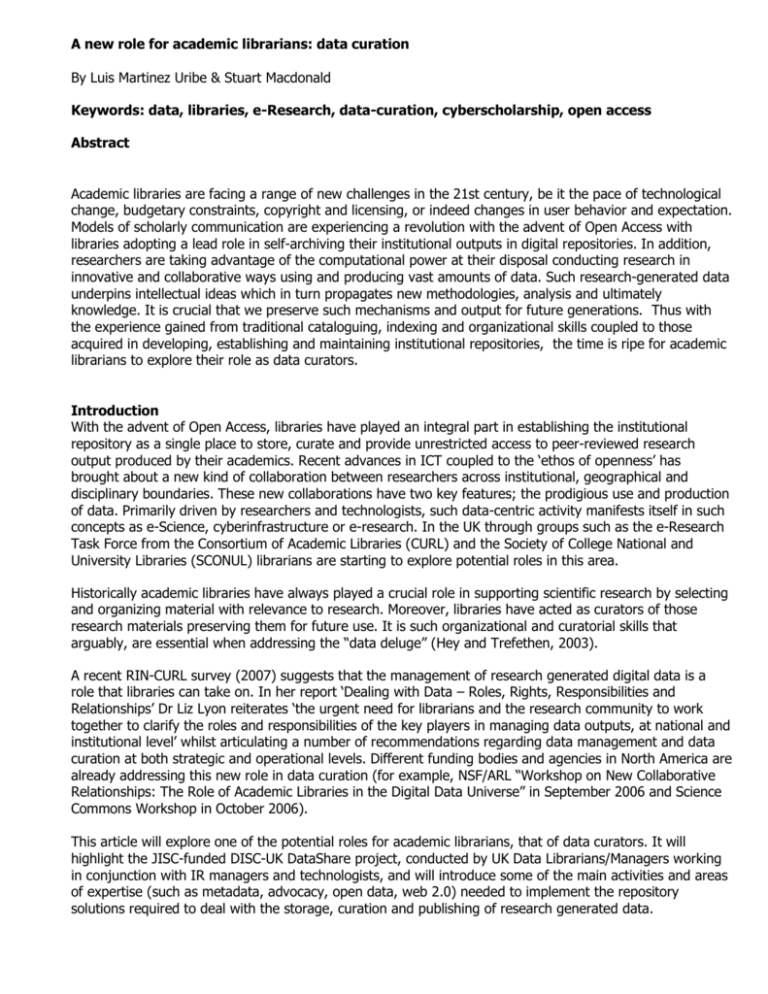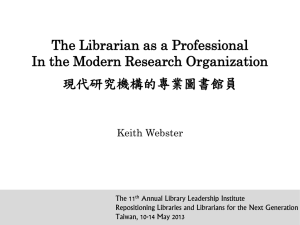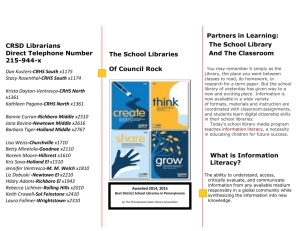A new role for academic librarians: data curation
advertisement

A new role for academic librarians: data curation By Luis Martinez Uribe & Stuart Macdonald Keywords: data, libraries, e-Research, data-curation, cyberscholarship, open access Abstract Academic libraries are facing a range of new challenges in the 21st century, be it the pace of technological change, budgetary constraints, copyright and licensing, or indeed changes in user behavior and expectation. Models of scholarly communication are experiencing a revolution with the advent of Open Access with libraries adopting a lead role in self-archiving their institutional outputs in digital repositories. In addition, researchers are taking advantage of the computational power at their disposal conducting research in innovative and collaborative ways using and producing vast amounts of data. Such research-generated data underpins intellectual ideas which in turn propagates new methodologies, analysis and ultimately knowledge. It is crucial that we preserve such mechanisms and output for future generations. Thus with the experience gained from traditional cataloguing, indexing and organizational skills coupled to those acquired in developing, establishing and maintaining institutional repositories, the time is ripe for academic librarians to explore their role as data curators. Introduction With the advent of Open Access, libraries have played an integral part in establishing the institutional repository as a single place to store, curate and provide unrestricted access to peer-reviewed research output produced by their academics. Recent advances in ICT coupled to the ‘ethos of openness’ has brought about a new kind of collaboration between researchers across institutional, geographical and disciplinary boundaries. These new collaborations have two key features; the prodigious use and production of data. Primarily driven by researchers and technologists, such data-centric activity manifests itself in such concepts as e-Science, cyberinfrastructure or e-research. In the UK through groups such as the e-Research Task Force from the Consortium of Academic Libraries (CURL) and the Society of College National and University Libraries (SCONUL) librarians are starting to explore potential roles in this area. Historically academic libraries have always played a crucial role in supporting scientific research by selecting and organizing material with relevance to research. Moreover, libraries have acted as curators of those research materials preserving them for future use. It is such organizational and curatorial skills that arguably, are essential when addressing the “data deluge” (Hey and Trefethen, 2003). A recent RIN-CURL survey (2007) suggests that the management of research generated digital data is a role that libraries can take on. In her report ‘Dealing with Data – Roles, Rights, Responsibilities and Relationships’ Dr Liz Lyon reiterates ‘the urgent need for librarians and the research community to work together to clarify the roles and responsibilities of the key players in managing data outputs, at national and institutional level’ whilst articulating a number of recommendations regarding data management and data curation at both strategic and operational levels. Different funding bodies and agencies in North America are already addressing this new role in data curation (for example, NSF/ARL “Workshop on New Collaborative Relationships: The Role of Academic Libraries in the Digital Data Universe” in September 2006 and Science Commons Workshop in October 2006). This article will explore one of the potential roles for academic librarians, that of data curators. It will highlight the JISC-funded DISC-UK DataShare project, conducted by UK Data Librarians/Managers working in conjunction with IR managers and technologists, and will introduce some of the main activities and areas of expertise (such as metadata, advocacy, open data, web 2.0) needed to implement the repository solutions required to deal with the storage, curation and publishing of research generated data. Open Data There has been much discussion in recent years about the merits of open standards, open source software, open access to scholarly publications through institutional or domain-specific repositories, and most recently open data. This discussion has indicated that such initiatives would lead to institutional and community benefits in terms of costs, greater accessibility to and long-term preservation of research output. It also indicates a recognition that there is a rising level of expectation among users for complete access to an intellectual work, not only the final published post-print, but the associated research output including methodologies (via Open Notebook, Open Science) and data. This is compatible with the scientific method of allowing replication of results by others, and the rich tradition of secondary analysis in the social sciences and other population-based research domains. It is also in line with several recent initiatives to open up publicly-funded research data to public availability such as the publication 2003 UNESCO Charter on the preservation of digital heritage [http://portal.unesco.org/ci/en/files/13367/10700115911Charter_en.pdf/Charter_en.pdf] and the OECD (2007) OECD Principles and guidelines for access to research data from public funding. Paris: OECD. Available from: http://www.oecd.org/dataoecd/9/61/38500813.pdf. There are of course reasons why data are not always provided in a completely open way. Aside from commercial value, these may include technical issues, confidentiality concerns, intellectual property rights, and sheer complexity. Issues such as these are currently being investigated in a number of projects such as the EC-funded DRIVER project[http://www.driver-repository.eu/], JISC-funded Digital Repositories programmes [http://www.jisc.ac.uk/whatwedo/programmes/digitalrepositories2007.aspx], the Australian Commonwealth Government-funded repository projects DART (http://www.dart.edu.au/) and ARCHER (http://archer.edu.au/) in addition to many North American initiatives such as the Dataverse Network project [http://thedata.org/]. e-Research, data and Libraries e-Research and data Advances in ICT are dramatically affecting the research process in all domains. With the increase in computing power researchers are able to process and share immense amounts of information. Like in a Virtual Organization (Foster 2001), collaborative and multidisciplinary research happens in disparate locations producing and using vast amounts of digital data. These new forms of research are known as eScience, e-Research with the cyberinfrastructure or e-Infrastructure as their technical backbone and support services. Such a domain has the potential of radically transforming the way research at large is conducted (Taylor 2001). Examples of e-Research initiatives spread across disciplines and include modeling experiments with hundreds of thousands of participants around the world attempting to forecast the weather on the 21st century (climateprediction.net); ontology driven databases with biological multi-dimension biological images (bioimage); virtual research environments where humans access and annotate collaboratively image collections of ancient documents (BVREH); or the grid infrastructure for neuroscientist to share data and expertise while archiving and curating image data from multiple sites (neurogrid). The data associated with such research activities come from a multitude of sources. They range from scientific experiments that investigate the behavior of the environment, measurements that record some aspects of it or simulations that test models. Rain precipitation measurements, astronomical observations, genetic modeling databases, crystallographic structures are specific examples of the data recorded in the big Sciences. In Social Science, data is generated from surveys that for instance canvas public opinion or digital maps with geo-referenced information associated showing unemployment levels at county level. In Humanities data may include pictures of ancient writings in stone and in Medical Science neuro-image data can record brain structures. However, as pointed out by Philip Lord & Alison Macdonald (2004), it is this fast changing technology that puts the digital data at risk of being lost if they are not properly curated and preserved. e-Research and Libraries Academic Libraries and researchers have traditionally had an intrinsic relationship. The selection, organization and long-term preservation of relevant research materials are activities at the core of academic librarianship. In a 21st century dominated by technological advances, libraries need to progress hand to hand with researchers and their new ways of conducting research. As Arms (2008) states ‘computer programs can identify latent patterns of information or relationships that will never be found by human searching and browsing. This new form of research can be called cybersholarship.’ He also goes on to say that the ‘limiting factor in the development of cybersholarship is likely to be a shortage of expertise’. The academic library community has realized the opportunities to become involved in this growing area of e-Research. A survey by the CURL/SCONUL Task Force on e-Research (Martinez 2007) was conducted to evaluate current levels of engagement of libraries with e-Research activities during Autumn 2006. It was clear from the results that librarians needed a better understanding of the term e-Research, more examples of e-Research activities happening and a clearer explanation of the role they could play. Two specific examples of the librarian's intervention in the e-Research environment are the 'staging repository' models as proposed by DataStaR project at Cornell University and the Data Curation Continuum at Monash University, Australia. Researchers can actively work with colleagues on metadata-lite but continually updated scientific data in 'collaboration' repositories before passing over the finished ‘static’ dataset to metadata-rich 'publication' repositories with the responsibility for preservation, management and open access resting with library/repository staff. As highlighted by the Research Information Network’s report (2007), the data management issues around e-Research, such as storage, annotation or preservation, that are of most interest to librarians. Nevertheless, this report is also cautious and throws the question “is this a job for academic librarians?” to the reader. Librarians do not necessarily feel comfortable with the handling of these complex and heterogeneous digital materials. Nevertheless, there is a particular group of librarians that, due to their area of expertise, is more eager to engage with e-Research activities: the Data Librarians. Data Libraries and Data Librarianship Data Libraries started back in the US in the 60s as support services assisting researchers in using data as part of their research activities as per the increase in machine readable data (Wright and Guy 1997). Technological advances have helped dictating the way these services have being developing. Today’s Data Libraries comprise collections of electronic data resources and a range of support services to help researchers to locate, access and use data. The International Association for Social Science and Information Service and Technology (IASSIST) is the organization that since 1974 brings together data professionals working with ICT to support research and teaching. One of its main efforts has been the promotion of international cooperation for best practice in the collection, processing, storage, retrieval, exchange and use of machine-readable data (O'Neil 2006). In European Universities there are relatively few ‘data services’ however American and Canadian universities have a strong tradition of this type of information service as highlighted by the Data Liberation Initiative (DLI) [http://www.statcan.ca/English/Dli/dli.htm], a co-operative initiative between Statistics Canada and Canadian Universities. The DLI was established in 1996 with an aim to raise the profile of research data through training and outreach. 25 institutions joined the initiative in 1996 however prior to the advent of the initiative there were only 6. In Canada there are now 70 tertiary education institutions with data services whereas in the UK there are 4 ‘data libraries’ – and according to JISC there are about twice as many HE institutions in the UK [http://www.jisccollections.ac.uk/jisc_banding.aspx]. Another example of North America leading the way in the area of data librarianship is at the University of Illinois Graduate School of Library and Information Science. As of this academic year data curation is a module as part of their Master's degree in Library and Information Science: http://www.lis.uiuc.edu/programs/ms/data_curation.html. This module offers a focus on data collection and management, knowledge representation, digital preservation and archiving, data standards, and policy. Students should thus be armed with data management skills which can be utilised in settings such as museums, data centres, libraries and institutional repositories, archives, and private industry. In the UK the first Data Library was set up in 1983 in the University of Edinburgh and currently there are ‘data library services’ at the London School of Economics (the Data Library and the Research Laboratory Data Service) and the University of Oxford. The universities of Southampton, Strathclyde and Nottingham also offer statistical and data support services. It should be noted that these facilities operate primarily within the social sciences arena. The Data Information Specialist Committee (DISC-UK) serves as the forum where professionals from the aforementioned institutions share experiences and expertise whilst supporting each other in addition to raising awareness of the importance of the institutional data support role. In the Netherlands, the Erasmus Data Service was set up after a Nereus workshop on Data Libraries organized at the LSE [http://www.lse.ac.uk/library/datlib/Nereus/] and in Spain, the Centre for Advance Study in the Social Sciences (CEACS) provides a data support service through its Social Science Library. Where data support services differ from conventional library services is the potential to establish and foster closer relationships between librarians and researchers. Librarians get to work on the coalface with researchers advising on where to locate resources, how to manage their data, how to gain access to resources or indeed troubleshoot data-related problems. This can also lead to the information specialist working as an integral part of research or project teams. Additionally, these services help to raise awareness of data resources available across institutions and beyond, and best practice in using these digital resources which in turn can generate interest amongst researchers who may request access to more resources. Data collections and the support services associated with them in many cases highlight the research agenda of an institution and can act as a selling point for universities to attract academics and students. With the advent of the OA movement and the growth of institutional repository services to store research outputs, data librarians and data managers have started to explore how to use this new infrastructure to deal with research data generated at their institutions. DISC-UK DataShare Project (for a distributed model of data repositories for UK HE Institutions) The JISC-funded DISC-UK DataShare project, led by EDINA, arises from an existing UK consortium of data support professionals working in departments and academic libraries in universities (DISC-UK), and builds on an international network with a tradition of data sharing and data archiving dating back to the 1960s in the social sciences as mentioned earlier. Its central aim is to develop a model for the deposit of research datasets in institutional repositories (IRs). Lyon observed that, whilst many institutions have developed IRs over the last few years to store and disseminate their published research outputs, “…there is currently no equivalent drive to manage primary data in a co-ordinated manner” (p.45)1. By working together across four UK universities and internally with colleagues already engaged in managing open access repositories for e-prints, the project will contribute to new models, workflows and tools for academic data sharing within a complex and dynamic information environment. It will also bring academic data libraries in closer contact with repository managers and develop new forms of cooperation between these distinct groups of information professionals. Although policies and practices currently operate to gather, store and preserve data, chiefly in national, subject-based data centres, much data remains unarchived and is at serious risk of being lost. The Data Sharing Continuum graph below shows how most datasets languish with minimum levels of management applied to them, while only a select few are given the highest levels of curation and prepared for publication. 1 LYON, L. (2007) Dealing with data: roles, responsibilities and relationships. Consultancy Report. Bath: UKOLN. http://www.jisc.ac.uk/media/documents/programmes/digital_repositories/ dealing_with_data_report-final.pdf Figure 1. the Data Sharing Continuum, Rice (2007) DISC-UK believes that IRs may be developed to rescue some of this ‘orphaned data’ and make it available for future research, to the benefit of research communities and wider society. It is worth pointing out that the distributed model of institutional repositories advocated by DataShare is not by any means the only model under consideration. A more centralized approach is being explored in the UK with the UK Research Data Service [http://www.curl.ac.uk/ukrds/], a one-year feasibility study conducted by industry consultants that will assess the cost implications of a shared service to deal with research data generated in UK HE institutions. The UK Data Archive are also investing in a new research output management and sharing system – UKDA-store. This service will be used by researchers to submit data deposits to a self-archiving repository with the right to set permissions for individual and group access, so that data can remain private (on embargo). This new service is to be initially released to the social science research community however it is intended that the system be extended to other disciplines. Data Curation In order to preserve research data for the future generations it is crucial that the communities of academic researchers who are users and producers of data, computing services who can manage ICT in organizations and libraries with their preservation skills and repository experience need to work together (Lyon 2007). The infrastructure required to do this does not only comprises the technical digital repositories where to store the data. It is important to take the appropriate measures from the moment of creation of these valuable digital assets (Doorn and Tjalsma 2007). All the activities geared towards this can be encapsulated in the relatively new concept of data curation. The Digital Curation Centre defines digital curation as: “The activity of managing and promoting the use of data from its point of creation, to ensure it is fit for contemporary purpose, and available for discovery and re-use.” Metadata A metadata standard that can help with the Curation of research data is DDI (data documentation initiative). A briefing paper produced by the DataShare project, “The Data Documentation Initiative and Institutional Repositories” presents this standard which deals with access, archiving and dissemination of social sciences datasets. A new version of the standard is about to be released, DDI 3, which documents the data throughout their life cycle, see picture below. Fig 2. The data life cycle, Ionescu (2007) This idea represents a complete shift from previous versions of the standard that proved to be too static to fulfil the requirements of data. In this new version, information gets capture by the data creators when the study is being designed, data is being collected and then processed. This should include provenance information: things like where and when the data was collected, what instruments were used and the ways in which the data was handled. Once the data is deposited in a repository, more information gets added to include the number of files and format of the data, access conditions and administrative information required for the long-term management of the digital object. The work carried out by the previous communities will help repositories to manage and preserve the materials effectively whilst researchers can access and understand them. Once data users discover a dataset and they are able to access, they may try to address new research questions and repurpose the data, by for instance merging it with another dataset, creating a new dataset (assuming that the legitimate rights are granted). It should be noted that there are a plethora of metadata standards which address a whole range of output at varying stages of the research lifecycle (e.g. resource description, administration, preservation) such as Dublin Core, METS, MODS, PREMIS however this should be a separate discussion. Licensing data There are many legislative intricacies governing researchers’ rights and responsibilities such as ownership and the re-use of derived data from licensed products are inevitably present when using repositories to disseminate research data and they need to be addressed. Until very recently, there were only two ways to protect your data from misuse: using database rights or copyright. These two mechanisms of protection would require someone wanting to use your data to gain permission in the form of a license. Of course this is not the ideal solution for someone wanting to share his data openly. The Open Data Commons project [http://www.opendatacommons.org/] has developed a set of licences based on the Sciences Common Protocol that attempts to deal with this. Harnessing Collective Intelligence* Both the StORe and GRADE projects from the JISC Digital Repositories Programme have gathered evidence suggesting that many scholars are more comfortable with an informal method of sharing, allowing them to assess the use to which the data will be put and decide whether to give the requestor access on a case by case basis. The emergence of Web 2.0 has transformed the web. We are seeing the boundaries between websites and web services blurring with a miriad of services and resources emerging, the content of which can be made available via a public interface or API (Application Programming Interfaces)[ http://en.wikipedia.org/wiki/API]. Such APIs require very rudimentary programming skills to mash and mix content from other sources to produce often populist but innovative products. To take advantage of such developments a range of collaborative utilities are emerging that publish and combine data outside of the repository environment allowing researchers to collaborate, analyse and share ideas and output across institution, national, and international boundary. There are literally hundreds of spatial data mash-ups available that can be created with very basic programming skills. Content from Web2.0 services, such as Flickr photographs, can be georeferenced, plotted, and visualized using a range of mapping services such as MS Virtual Earth, Google Earth, Yahoo Maps, and NASA's World Wind. Programmableweb (:www.programmableweb.com/tag/mapping) lists approximately 1,500 spatial mash-ups that utilize a whole range of Web2.0 services. However, GeoCommons (http://geocommons.com/), in a sense, formalizes a spatial approach to data visualization. This utility allows users to upload, download, and search for spatial data; create mashups by combining datasets; and create thematic maps. There are a range of other standalone utilities which offer much the same functionality such as Platial (http://www.platial.com/splash) and Mapbuilder (http://www.mapbuilder.net/). Large research organizations are exposing their research findings through Google Earth, for example, the NERC-funded British Oceanographic Data Centre [http://www.bodc.ac.uk/about/news_and_events/google_earth.html] have written a Keyhole Markup Language (KML) [http://en.wikipedia.org/wiki/Keyhole_Markup_Language] generator to automatically provide a KML file for each data request in order to enhance their spatial information. The USGS Earthquake Hazards Program display real-time earthquakes and plate boundaries in Google Earth [http://earthquake.usgs.gov/research/data/google_earht.php]. Indeed academics are also embracing such technologies to enhance their research, for example researchers at John Hopkins University’s have developed an Interactive Map Tool which supports digital field assignments allowing users to create custom mashups using a variety of digital media, text and data – http://www.cer.jhu/index.cfm?pageID=351 . The Minnesota Interactive Internet Mapping Project have developed a mapping application that provides maps and imagery similar to Google Maps – claims to be data rich, interactive, secure, easy to use, have analytical capabilities - http://maps.umn.edu/. Research at Pompeu Fabra University, Barcelona are mining spatial-temporal data provided by geotagged Flickr photos of urban locations – http://www.giradin.org/fabien/tracing/. In addition to the spatial visualization arena there are a host of services which venture into the numeric data space. These utilities allow researchers to upload and analyse their own data in ‘open’ and dynamic environments. Services such as Swivel, Many Eyes, StatCrunch, Graphwise can be regarded as ‘open data’ utilities in that they retain the ethos of other ‘open’ initiatives by allowing anyone to upload or use the data. They are generally commercial services by nature which embrace a Web 2.0 business model in which adverts are imbedded within services or users pay to access additional features such as maintaining private data collaborations. Non- and Inter-Governmental Organisations are also employing cutting-edge data visualisation and dissemination tools for country-level statistics which span both the numeric and spatial data arenas. At present users cannot upload and publish their own data, although this may not always be the case. Examples include: OECD Country Statistical Profiles – OECD statistics in SDMX (Statistical Data Mark-up eXchange) http://stats.oecd.org/nawwe/csp/default.html IMF Data Mapper http://www.imf.org/external/datamapper/index.php This, one would imagine is just the tip of the iceberg with regards to data publishing and visualization. As Web 2.0 continues to evolve and emerge as Web 3.0 the entire system is turning into both a platform and the global database (see www.twine.com, www.freebase.com etc) with spatial and numeric data visualization being but a small component of the continual evolution that is the web. *Harnessing Collective Intelligence was the second of Tim O'Reilly's seven principles in his famous 2005 article ‘What is Web 2.0?’ [http://www.oreillynet.com/pub/a/oreilly/tim/news/2005/09/30/what-is-web-20.html?page=1]. Conclusion In the formative landscape of scholarly communication and research practice, there are many opportunities for academic libraries to nurture and develop their expertise, skill sets and services. Research data presents many challenges; data range from the simple to the complex, from homogeneous to proprietory in format. Moreover, there is a lack of standards to describe data across disciplines. Academic libraries could play a role in the organization and preservation of these types of research outputs. For this, roles like the data librarian can help the library world in making sense of this multifarious, dynamic and challenging arena. Authors Luis Martinez-Uribe Luis is a graduate in Mathematics from the Universidad Complutense de Madrid and holds a MSc in Information Systems from the Department of Management at the London School of Economics. He worked as a Data Librarian at the British Library of Political and Economic Science from 2001 until 2007 and in 2008 he has started a new role as the Digital Repositories Research Co-ordinator at the Oxford e-Research Centre in the University of Oxford. Place of work : Oxford e-Research Centre, Address: 7 Keble Road Oxford OX1 3QG United Kingdom Email :luis.martinez-uribe@oerc.ox.ac.uk Blog : http://oxdrrc.blogspot.com/ Stuart Macdonald Stuart is a graduate in Biochemistry from Heriot-Watt University, Edinburgh with a postgraduate diploma in Information Studies from Strathclyde University, Glasgow. He has worked as a Data Librarian at Edinburgh University Data Library and the EDINA National Data Centre since 1999. He is a project officer with the JISC-funded DISC-UK datashare project and editor of Intute Social Sciences Statistics and Data. Place of work : EDINA National Data Centre & Edinburgh University Data Library Address: Causewayside House, 160 Causewayside, Edinburgh EH9 1PR, Scotland Email: stuart.macdonald@ed.ac.uk References Doorn, Peter y Tjalsma, Heiko “Introduction: Archiving research data” Archival Science 7: 1-20 , 2007 Foster, I., C. Kesselman and S. Tuecke "The Anatomy of the Grid: Enabling Scalable Virtual Organizations", International Journal of High Performance Computing Applications, 15 (3) pp. 200-222, 2001. Hey, Tony y Trefethen, Anne "The Data Deluge: An E-Science Perspective" en: Berman, F., Fox, G. C. and Hey, A. J. G. Grid Computing - Making the Global Infrastructure a Reality, Wiley and Sons, 2003, Reino Unido, pp. 809-824. ISBN 978-0-470-85319-1 Hey,Tony “ E-science and the Research Grid” The Digital Curation: digital archives, libraries and e-science seminar, 2001. http://www.dpconline.org/graphics/events/presentations/pdf/tonyhey.pdf Ionescu, Sanda “Introduction to DDI 3.0” CESSDA Expert Seminar, September 2007 Lyon, Liz “Dealing with Data – Roles, Rights, Responsibilities and Relationships” Informe de UKOLN para the Joint Information Systems Committee, Bath, 2007. http://www.ukoln.ac.uk/projects/data-clusterconsultancy/briefing-paper/briefing-final.pdf Macdonald Stuart & Martinez, Luis “ Supporting local data users in the UK Academic Community“ Ariadne Issue 44, 2005. http://www.ariadne.ac.uk/issue44/martinez/ Martinez, Luis “ The e-Research needs analysis survey report” Informe de CURL/SCONUL Task Force on eResearch, 2007 http://www.curl.ac.uk/about/groupsEResJoint.htm O'Neill Adams "The Origins and Early Years of IASSIST" IASSIST Quaterly Fall 2006 Philip Lord & Alison Macdonald “Digital data – a new knowledge based research” Informe del Joint Information Systems Committee, 2004. http://www.jisc.ac.uk/publications/publications/pub_escience.aspx RIN-CURL "Researcher’s Use of Academic Libraries and Their Services" Informe del Research Information Network, Londres, 2007. http://www.rin.ac.uk/researchers-use-libraries. William Arms states “High Performance Computing Meets Digital Libraries”, Journal of Electronic Publishing, Winter 2008 http://hdl.handle.net/2027/spo.3336451.0011.103 Wright, Melanie and Laura Guy. "Where do I find it and what do I do with it: practical problem-solving in the data library," IASSIST/IFDO Conference, Odense, Denmark, May 6-9, 1997, http://dpls.dacc.wisc.edu/types/data_reference.htm Appendix 1. Social Networking The environment described above is complex, dynamic, and ever-changing. There are a number of resources embracing Web2.0 technologies that aim to keep practitioners up-to-date with news and activities in this area. There are a range of authoritative weblogs and syndication feeds that address the ‘open movement’, eresearch and digital science such as: Peter Suber’s Open Access News (www.earlham.edu/~peters/fos/fosblog.html) The Research Information Network’s Team Blog (www.rin.ac.uk/team-blog( Open Knowledge Foundation Weblog (http://blog.okfn.org/) Peter Murray Rust’s Blog (http://wwmm.ch.cam.ac.uk/blogs/murrayrust/) OA Librarian (http://oalibrarian.blogspot.com/) Digital Curation Centre Blog (http://digitalcuration.blogspot.com/) National e-Science Centre RSS news feeds (http://www.nesc.ac.uk/news/rss/index.html) There are a number of Facebook groups addressing the subject of open access, including: Librarians Who Support Open Access SPARC (Scholarly Publishing and Academic Resources Coalition)





